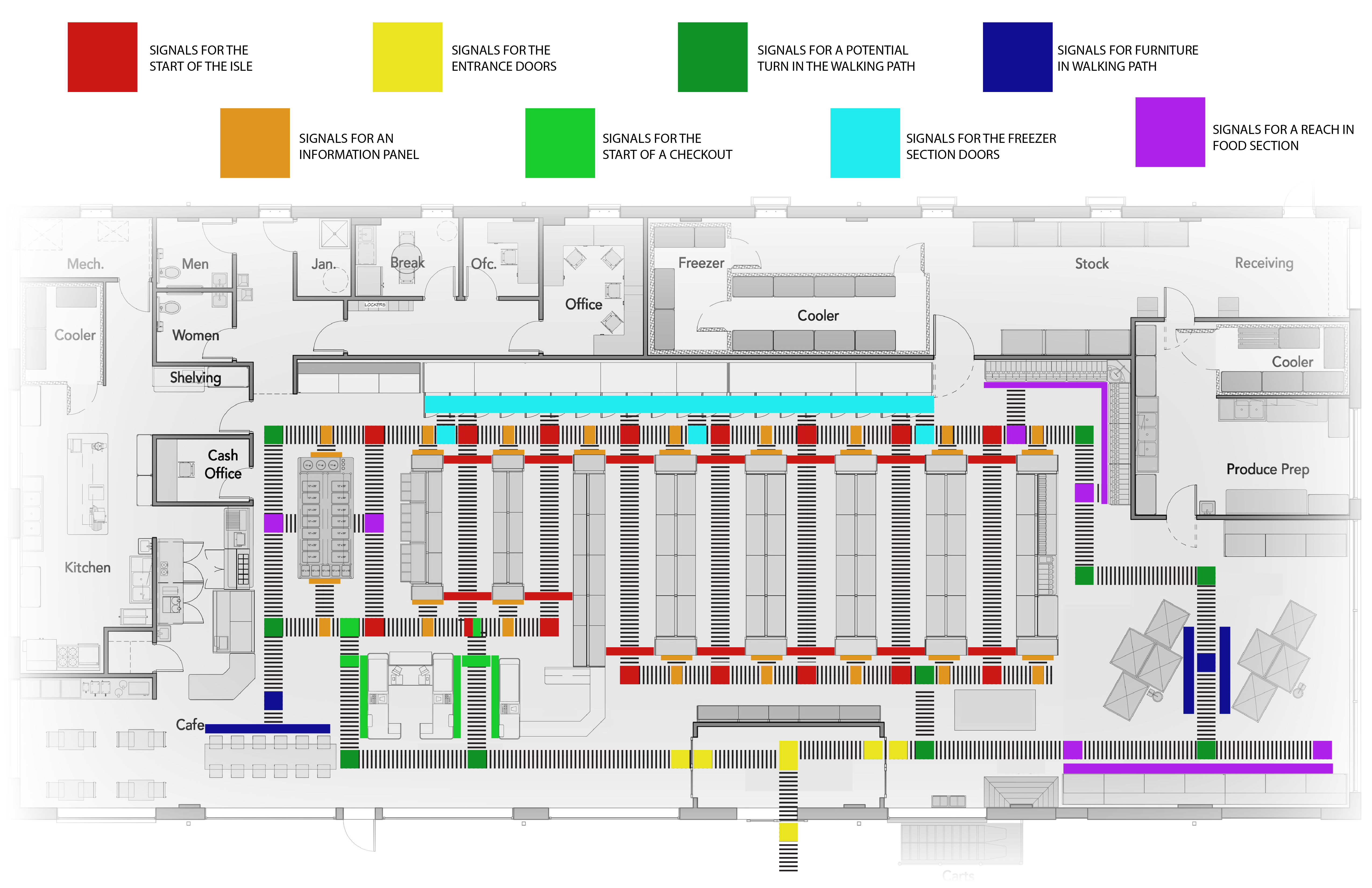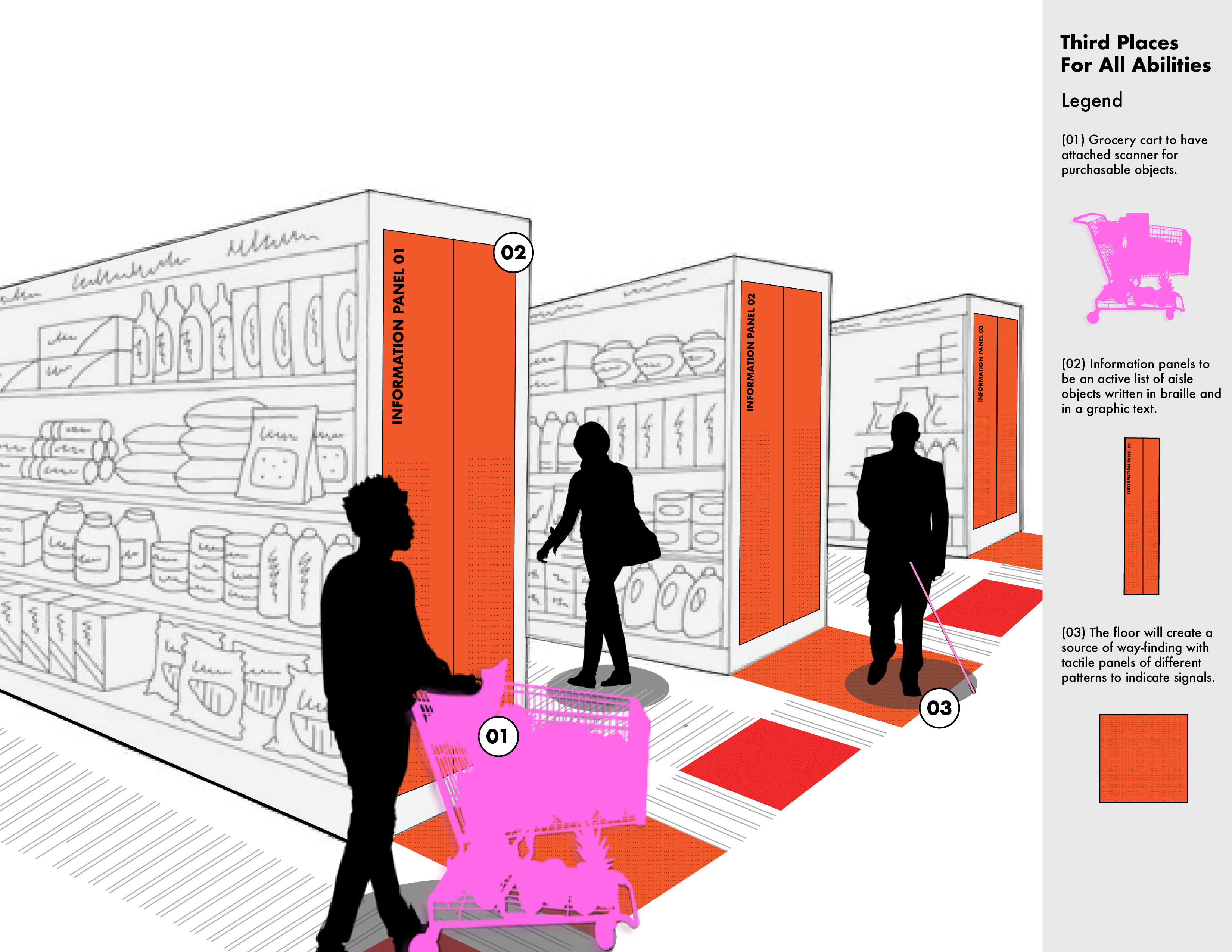︎ Third Places For All Abilities:
Food Markets that Enable Independence
How do we design spaces that enable older adults with a visual impairment to age in place?
By Brian Silva ︎, Rohini Perera ︎, Lauren Jenkins ︎


Hypothesis
By 2050, 702.2 million people are predicted to have some form of visual impairment (VI). According to Swenor et al., VI can either directly affect/mediate/moderate physical, cognitive, and social functioning of an older adult. As these are all domains that contribute to aging in place, we hypothesize that our proposed design will enable an older adult with VI to maintain physical, cognitive and social function through engagement in third places.
By 2050, 702.2 million people are predicted to have some form of visual impairment (VI). According to Swenor et al., VI can either directly affect/mediate/moderate physical, cognitive, and social functioning of an older adult. As these are all domains that contribute to aging in place, we hypothesize that our proposed design will enable an older adult with VI to maintain physical, cognitive and social function through engagement in third places.
Why
According to the United Census Bureau, approximately 83.7 million of the US population will be aged 65 years or older in 2050. The independence of the elderly with vision impairment is limited, and little assistance is provided when navigating the urban environment for necessities such as groceries and community engagement. Interventions for older adults with VI need to be tailored as their needs vary greatly when compared to older adults without VI. Most environments are built for the able-bodied with little consideration for the elderly and disabled. This often creates barriers and doubles the physical and mental effort in public spaces.
How
Our approach will function through human-centered design that will engage with a variety of human senses. This will enable older adults with VI to live independently, while remaining connected to their communities.
What
Our aim is to tackle an everyday task and make it more accessible to those who are blind or losing vision. By accessing other sensory stimuli, we can create a space that allows for those who are visually impaired to navigate through the grocery store following a specific recipe. The proposed design also addresses social isolation among older adults by designing a space that makes visiting third places (i.e. grocery stores, coffee shops) easy. The proposed design addresses the following on the design continuum: product (tactile grocery cart), interior (tactile grocery aisle), architecture (tactile grocery store and connected coffee shop), and the urban realm (area surrounding grocery store).
So What
The National Academies of Sciences, Engineering, and Medicine (NASEM) reports that nearly one-fourth of older adults are considered to be socially isolated. Our inclusive design creates a welcoming store that reduces stress in those who are visually impaired, which will ultimately encourage older adults with VI to visit their local grocery stores. This will enable them to regain their lost independence, while allowing them to stay connected with their community.
According to the United Census Bureau, approximately 83.7 million of the US population will be aged 65 years or older in 2050. The independence of the elderly with vision impairment is limited, and little assistance is provided when navigating the urban environment for necessities such as groceries and community engagement. Interventions for older adults with VI need to be tailored as their needs vary greatly when compared to older adults without VI. Most environments are built for the able-bodied with little consideration for the elderly and disabled. This often creates barriers and doubles the physical and mental effort in public spaces.
How
Our approach will function through human-centered design that will engage with a variety of human senses. This will enable older adults with VI to live independently, while remaining connected to their communities.
What
Our aim is to tackle an everyday task and make it more accessible to those who are blind or losing vision. By accessing other sensory stimuli, we can create a space that allows for those who are visually impaired to navigate through the grocery store following a specific recipe. The proposed design also addresses social isolation among older adults by designing a space that makes visiting third places (i.e. grocery stores, coffee shops) easy. The proposed design addresses the following on the design continuum: product (tactile grocery cart), interior (tactile grocery aisle), architecture (tactile grocery store and connected coffee shop), and the urban realm (area surrounding grocery store).
So What
The National Academies of Sciences, Engineering, and Medicine (NASEM) reports that nearly one-fourth of older adults are considered to be socially isolated. Our inclusive design creates a welcoming store that reduces stress in those who are visually impaired, which will ultimately encourage older adults with VI to visit their local grocery stores. This will enable them to regain their lost independence, while allowing them to stay connected with their community.


The Link Between Design and Outcomes
Due to the aging population and the predicted increase in prevalence of VI, we are hopeful that this design can lead the way to create third spaces that allow individuals of all abilities to age in place.
︎
Works Cited
1. Swenor BK, Lee MJ, Varadaraj V, Whitson HE, Ramulu PY. Aging With Vision Loss: A Framework for Assessing the Impact of Visual Impairment on Older Adults. Gerontologist. 2020;60(6):989-995. doi:10.1093/geront/gnz117
2. Bourne RRA, Flaxman SR, Braithwaite T, et al. Magnitude, temporal trends, and projections of the global prevalence of blindness and distance and near vision impairment: a systematic review and meta-analysis. The Lancet Global Health. 2017;5(9):e888-e897. doi:10.1016/S2214-109X(17)30293-0
3. Annele U, Satu KJ, Timo ES. Definitions of successful ageing: A brief review of a multidimensional concept. Acta Biomed. 2019;90(2):359-363. doi:10.23750/abm.v90i2.8376
4. Bureau UC. An Aging Nation: The Older Population in the United States. Census.gov. Accessed September 30, 2023. https://www.census.gov/library/publications/2014/demo/p25-1140.html
5. Finlay J, Esposito M, Kim MH, Gomez-Lopez I, Clarke P. Closure of ‘Third Places’? Exploring Potential Consequences for Collective Health and Wellbeing. Health Place. 2019;60:102225. doi:10.1016/j.healthplace.2019.102225
6. The Senses: Design Beyond Vision | Cooper Hewitt, Smithsonian Design Museum. Published March 5, 2018. Accessed October 1, 2023. https://www.cooperhewitt.org/publications/the-senses-design-beyond-vision/
7. Future RT. 10 Great examples of Architecture for the blind around the world. RTF | Rethinking The Future. Published December 29, 2020. Accessed October 1, 2023. https://www.re-thinkingthefuture.com/designing-for-typologies/a2660-10-great-examples-of-architecture-for-the-blind-around-the-world/
8. Sharma N. Designing a Grocery Store Experience for Visually impaired. Medium. Published January 19, 2022. Accessed October 1, 2023. https://bootcamp.uxdesign.cc/designing-a-grocery-store-experience-for-visually-impaired-d64d82c97183
9. Tactile City. Tactile City. Accessed October 1, 2023. http://www.tactilecity.org